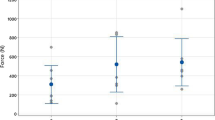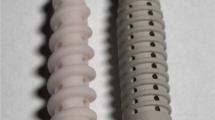Abstract
Bone tunnel fixation of a soft tissue tendon graft is the weak link immediately following ACL reconstruction. This biomechanical study evaluated the influence of extraction drilled or step dilated bone tunnels and bioabsorbable screw divergence on soft tissue tendon graft fixation. From an initial group of 50 available specimens, similar apparent bone mineral density porcine tibiae (1.2 ± 0.24 g/cm2) were divided into two groups of ten specimens each. Group 1 (extraction drilled) received 9 mm diameter tunnels. Group 2 (step dilated) received 7 mm diameter tunnels that were dilated to 9 mm. Grafts were secured in tunnels using 10 mm diameter, 35 mm long tapered screws. After high resolution CT scanning to evaluate screw divergence, constructs were pretensioned on a servo hydraulic device between 10 and 50 N for 10 cycles, and isometric pretensioned at 50 N for 1 min, prior to 500 sub-maximal loading cycles (50–200 N) and load to failure testing at 20 mm/min. Wilcoxon Signed Rank tests and Mann–Whitney U-tests were used to evaluate group differences. Coefficient of determination values (r 2) were calculated to further delineate statistically significant relationships. Tunnel preparation method did not display statistically significant effects on insertion torque, displacement during cyclic testing, relative stiffness during cyclic testing, load at failure, stiffness during load to failure testing or displacement during load to failure testing. Screw divergence < 15° produced lower displacement and greater relative stiffness during cyclic testing and greater load at failure and stiffness during load to failure testing. Screw divergence angle displayed moderate relationships with construct displacement during cyclic testing (r 2 = 0.54), stiffness during load to failure testing (r 2 = 0.60), and load at failure (r 2 = 0.41). Tunnel dilation does not enhance soft tissue tendon graft fixation strength in healthy bone. Bioabsorbable screw divergence of ≥ 15° significantly reduces soft tissue tendon graft-bone tunnel fixation.









Similar content being viewed by others
References
Adam F, Pape D, Schiel K, Steimer O, Kohn D, Rupp S (2004) Biomechanical properties of patellar and hamstring graft tibial fixation techniques in anterior cruciate ligament reconstruction. Am J Sports Med 32(1):71–78
Bailey SB, Grover DM, Howell SM, Hull ML (2004) Foam-reinforced elderly human tibia approximates young human tibia better than porcine tibia. Am J Sports Med 32(3):755–764
Beynnon BD, Amis AA (1998) In vitro testing protocols for the cruciate ligaments and ligament reconstructions. Knee Surg Sports Traumatol Arthrosc 6(Suppl 1):S70–S76
Brand JC Jr, Pienkowski D, Steenlage E, Hamilton D, Johnson DL, Caborn DNM (2000a) Interference screw fixation strength of a quadrupled hamstring tendon graft is directly related to bone mineral density and insertion torque. Am J Sports Med 28:705–710
Brand JC Jr, Weiler A, Caborn DNM, Brown CH Jr, Johnson DL (2000b) Graft fixation in cruciate ligament reconstruction. Am J Sports Med 28:761–774
Brand JC Jr, Caborn DNM, Johnson DL (2003) Biomechanics of soft-tissue interference screw fixation for anterior cruciate ligament reconstruction. Orthop 26:432–439
Caborn DN, Nyland J, Selby J, Tetik O (2003) Biomechanical testing of hamstring graft tibial tunnel fixation with bioabsorbable interference screws. Arthroscopy 19(9):991–996
Cain EL, Phillips BB, Charlebois SJ, Azar FM (2005) Effect of tibial tunnel dilation on pullout strength of semitendinosus-gracilis graft in anterior cruciate ligament reconstruction. Orthop 28(8):779–783
Charlick DA, Caborn DNM (2000) Technical note: alternative soft-tissue graft preparation technique for cruciate ligament reconstruction. Arthroscopy 16(8):E20
Heinonen A, Oja P, Kannus P, et al (1995) Bone mineral density in female athletes representing sports with different loading characteristics of the skeleton. Bone 17(3):197–203
Jarvinen TL, Kannus P, Sievanen H, Jolma P, Heinonen A, Jarvinen M (1998) Randomized controlled study of effects of sudden impact loading on rat femur. J Bone Miner Res 13:1475–1482
Jomha NM, Raso VJ, Leung P (1993) Effect of varying angles on the pullout strength of interference screw fixation. Arthroscopy 9:580–583
Kocabey Y, Nawab A, Caborn DNM, Nyland J (2004) EndoPearl augmentation of bioabsorbable interference screw fixation of a soft tissue tendon graft in a tibial tunnel. Arthroscopy 20(6):658–661
Kousa P, Jarvinen TLN, Vihavainen M, Kannus P, Jarvinen M (2003) The fixation strength of six hamstring tendon graft fixation devices in anterior cruciate ligament reconstruction. Part I femoral site. Am J Sports Med 31:174–181
Kousa P, Jarvinen TL, Vihavainen M, Kannus P, Jarvinen M (2003) The fixation strength of six hamstring tendon graft fixation devices in anterior cruciate ligament reconstruction. Part II: tibial site. Am J Sports Med 31:182–188
Lemos MJ, Jackson DW, Lee TQ, Simon TM (1995) Assessment of initial fixation of endoscopic interference screw fixation. Arthroscopy 11:37–41
Leppala J, Kannus P, Natri A, et al (1999) Effect of anterior cruciate ligament injury of the knee on bone mineral density of the spine and affected lower extremity: a prospective one-year follow-up study. Calcif Tissue Int 64:357–363
Miller CM, Tibone JE, Hewitt M, Kharrazi DF, El Attrache NS (2002) Interference screw divergence in femoral tunnel fixation during endoscopic anterior cruciate ligament reconstruction using hamstring grafts. Arthroscopy 18(5):510–514
Nakano H, Yasuda K, Tohyama H, Yamanaka M, Wada T, Kaneda K (2000) Interference screw fixation of doubled flexor tendon graft in anterior cruciate ligament reconstruction: biomechanical evaluation with cyclic elongation. Clin Biomech 15:188–195
Nurmi JT, Jarvinen TLN, Kannus P, Sievanen H, Toukosalo J, Jarvinen M (2002) Compaction versus extraction drilling for fixation of the hamstring tendon graft in anterior cruciate ligament reconstruction. Am J Sports Med 30:167–173
Nurmi JT, Kannus P, Sievanen H, Jarvela T, Jarvinen M, Jarvinen TLN (2004) Interference screw fixation of soft tissue grafts in anterior cruciate ligament reconstruction: Part 1. Effect of tunnel compaction by serial dilators versus extraction drilling on the initial fixation strength. Am J Sports Med 32(2):411–417
Nurmi JT, Kannus P, Sievanen H, Jarvinen M, Jarvinen TLN (2003) Compaction drilling does not increase the initial fixation strength of the hamstring tendon graft in anterior cruciate ligament reconstruction in a cadaver model. Am J Sports Med 31:353–358
Nurmi JT, Sievanen H, Kannus P, Jarvinen M, Jarvinen TLN (2004) Porcine tibia is a poor substitute for human cadaver tibia for evaluating interference screw fixation. Am J Sports Med 32(3):765–771
Pierz K, Baltz M, Fulkerson J (1995) The effect of Kurosaka screw divergence on the holding strength of bone-tendon-bone grafts. Am J Sports Med 23(3):332–335
Rittmeister M, Noble P, Bocell JR Jr, Alexander JW, Conditt MA, Kohl HW (2001) Interactive effects of tunnel dilation on the mechanical properties of hamstring grafts fixed in the tibia with interference screws. Knee Surg Sports Traumatol Arthrosc 9:267–271
Robbe R, Johnson DL (2002) Graft fixation alternatives in anterior cruciate ligament reconstruction. Univ Penn Orthop J 15:21–28
Rodeo SA, Arnoczky SP, Torzilli PA, Hidaka C, Warren RF (1993) Tendon-healing in a bone tunnel. J Bone Joint Surg Am 75:1795–1803
Rodin D, Ley IM (2003) The use of intraoperative fluoroscopy to reduce femoral interference screw divergence during endoscopic anterior cruciate ligament reconstruction. Arthroscopy 19(3):314–317
Sievanen H, Koskue V, Rauhio A, Kannus P, Heinonen A, Vuori I (1998) Peripheral quantitative computed tomography in human long bones: evaluation of in vitro and in vivo precision. J Bone Miner Res 13:871–882
Steenlage E, Brand JC Jr, Johnson DL, Caborn DN (2002) Correlation of bone tunnel diameter with quadrupled hamstring graft fixation strength using a biodegradable interference screw. Arthroscopy 18:901–907
Steiner ME, Hecker AT, Brown CH Jr, Hayes WC (1994) Anterior cruciate ligament graft fixation. Comparison of hamstring and patellar grafts. Am J Sports Med 22:240–246
Vuori I, Heinonen A, Sievanen H, Kannus P, Pasanen M, Oja P (1994) Effects of unilateral strength training and detraining on bone mineral density and content in young women: a study of mechanical loading and deloading on human bones. Calcif Tissue Int 55:59–67
Weiler A, Hoffman RFG, Siepe CJ, Kolbeck SF, Sudkamp NP (2000) The influence of screw geometry on hamstring tendon interference fit fixation. Am J Sports Med 28:356–359
Weiler A, Hoffmann RFG, Stahelin AC, Bail HJ, Siepe CJ, Sudkamp NP (1998) Hamstring tendon fixation using interference screws: a biomechanical study in calf tibial bone. Arthroscopy 14:29–37
Yamanaka M, Yasuda K, Tohyama H, Nakano H, Wada T (1999) The effect of cyclic displacement on the biomechanical characteristics of anterior cruciate ligament reconstructions. Am J Sports Med 27:772–777
Acknowledgments
Thanks for the support provided by the University of Louisville Summer Scholars Program and Arthrex Inc. Also, thanks to Seid Waddell and Dr. Mike Voor for their technical assistance.
Author information
Authors and Affiliations
Corresponding author
Rights and permissions
About this article
Cite this article
Duffee, A.R., Brunelli, J.A., Nyland, J. et al. Bioabsorbable screw divergence angle, not tunnel preparation method influences soft tissue tendon graft-bone tunnel fixation in healthy bone. Knee Surg Sports Traumatol Arthr 15, 17–25 (2007). https://doi.org/10.1007/s00167-006-0116-8
Received:
Accepted:
Published:
Issue Date:
DOI: https://doi.org/10.1007/s00167-006-0116-8




